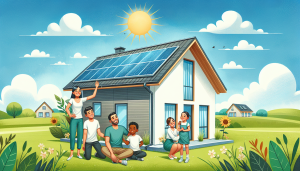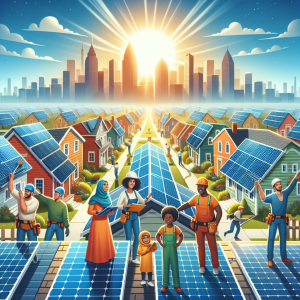Alright folks, gather ’round! Today, we’re diving into the epic battle of sustainability vs resilience. Now, don’t worry, no trees or eco-warriors will be harmed in the making of this article. Ready to dive in? Let’s go!
Sustainability vs Resilience: Introducing the Heavyweights!
Ever had a friend claim they’re sustainable because they remember to turn off the lights, but their life seems to crumble at the first sign of adversity? Or perhaps someone who bounces back from every challenge but couldn’t care less about recycling? Well, they’re embodying our two titans today.
Defining Sustainability
Ah, sustainability. It’s a buzzword we’ve heard at eco-rallies, in corporate boardrooms, and over those “organic-only” branches. But what does it really mean?
At its core, sustainability is a lot like good ol’ grandma’s advice: “Don’t be greedy!” It encourages us to use resources judiciously so that there’s enough left for everyone else. And by everyone else, I mean not just your next-door neighbour but also that child who’ll be born 100 years from now.
Imagine you’ve got a giant chocolate cake (yes, the moist, melt-in-the-mouth kind). If you gobble up the entire thing today, there’s none left for tomorrow. But if you take a slice every day, making sure not to eat so much that it can’t replenish itself, then you have a cake that might just last indefinitely. That’s sustainability for you, in a chocolaty nutshell.
In a more technical avatar, sustainability focuses on three pillars, often referred to as the Three Ps:
- Planet: This refers to the environment. Sustainable actions aim to reduce the degradation of our planet. Think: reducing emissions, conserving water, and not turning our forests into paper factories.
- People: It’s not just about Earth. It’s about ensuring that communities can thrive. This includes fair wages, equal opportunities, and not making kids work in sneaker factories.
- Profit: This might come as a surprise, but yes, sustainability also talks about making money. But not the Scrooge-McDuck-diving-into-a-pool-of-gold kind. It’s profit that doesn’t come at the expense of the planet or people.

Resilience 101
Roll up those sleeves, folks, because it’s time to meet resilience, the Rocky Balboa of the environmental and societal world. While sustainability plays the long game, resilience is all about taking the hits and, as Rocky would put it, “keep moving forward.
● The Essence of Resilience
Have you ever watched those inflatable clowns that bounce back no matter how hard you punch them? Yep, that’s resilience in action. It’s about the capacity of systems, communities, or individuals to absorb shocks and disturbances (like, say, natural disasters or economic downturns) and not just recover, but also adapt and grow from these experiences. Think of it like upgrading your armor every time you face a challenge.
● The Multi-Dimensional Marvel
What’s uber-cool about resilience is that it’s not a one-trick pony. Nope. It operates on several levels:
- Personal Resilience: This is about you, me, and the lady at the grocery store who’s endured personal adversities and come out stronger. It’s about our ability to cope, adapt, and thrive amidst challenges.
- Community Resilience: Think of a close-knit neighborhood that rallies together after a storm, sharing resources, supporting each other, and rebuilding better than before.
- Systemic Resilience: This zooms out to look at larger systems like cities, economies, or ecosystems. Can a city recover quickly from a blackout? How about an economy bouncing back after a recession?

Why It’s Not Just About Bouncing Back
Let’s bust a myth: resilience isn’t just about getting back to where you were. It’s also about learning, adapting, and positioning yourself (or your community or ecosystem) to better face future shocks. Imagine getting a small cut on your hand. Over time, not only does the skin heal, but it also might toughen up a bit in that spot, making it slightly more resistant to future cuts.
Resilience vs. Robustness
Now, don’t confuse resilience with robustness. While robustness is about resistance and strength (think of a fortress that’s hard to breach), resilience acknowledges vulnerabilities but possesses the mechanisms to recover and adapt.
The Golden Ingredient: Adaptability
The heart of sustainability vs resilience lies in adaptability. It’s the secret sauce, the magic ingredient. Just as water takes the shape of its container, resilience is about adjusting, evolving, and sometimes even transforming in the face of disturbances.
The Historical Rumble: Origin Stories
Before we dive deeper, let’s take a time machine back to when these terms were mere infants.
How Sustainability Became a Buzzword
Let’s dive into the time machine and unpack the journey of “sustainability”. From its academic cocoon to becoming the pop star of environmental terms, this word has had one wild ride!
The Humble Beginnings
Historically, societies always had a knack for living within their means. Indigenous tribes and ancient civilizations instinctively practised sustainable methods, be it in farming, hunting, or building. But, it wasn’t labelled as “sustainability” then. More like plain old wisdom.
The Industrial Revolution’s Double-edged Sword
Enter the Industrial Revolution. Machines and factories sprung up, reshaping landscapes and lives. This age accelerated progress, but with a twist. Our air got murkier, lands more barren, and resources alarmingly scarce. The world felt the pinch, but our star word “sustainability” was still gearing up backstage.
The 1970s: The Green Stirring
The 1970s can be dubbed the “teenage years” of sustainability. Influences like Rachel Carson’s “Silent Spring” had already sown the seeds of environmental consciousness. This decade watered it. The oil crisis, mounting pollution, and population growth concerns hinted at our planet’s limits. It was in this era that the United Nations stepped in, holding its first major conference on international environmental issues. Global sustainability chit-chats began!
Brundtland Commission: The Name Game
1987 was a landmark year. The World Commission on Environment and Development, known as the Brundtland Commission, dropped their report “Our Common Future.” This was the debut of “sustainable development,” defined as meeting today’s needs without jeopardising future generations’. And voila! The buzz took off!
21st Century: Green Is the New Black
With the new millennium, sustainability wasn’t just a whispered concept among eco-warriors. The changing climate, extreme weather patterns, and global teamwork catapulted it into universal recognition. It transitioned from an environmentalist’s chant to a corporate mission, from school lessons to government policies. Being “green” was suddenly in vogue!
Media & Celeb Spotlight
Lastly, the role of media and star power can’t be ignored. Documentaries and celebrities (looking at you, DiCaprio!) amplified the sustainability message, making it a central theme in global discussions.
The Birth of Resilience Thinking
The concept of resilience has evolved over time, moving from the realm of ecology to a multidimensional approach influencing societal, economic, and individual scales. Let’s peel back the layers and dive into the origin and rise of resilience thinking.
Ecological Beginnings
Resilience first poked its head into the scientific lexicon in the context of ecology during the 1970s. Ecologist C.S. Holling, the granddaddy of resilience theory, introduced the term to describe the capacity of ecosystems to absorb disturbances and still maintain their essential functions. For Holling, it wasn’t just about an ecosystem bouncing back to its original state, but potentially transforming into another stable state. It challenged the previously held belief of nature always achieving a stable equilibrium.
Disaster and Response
During the latter part of the 20th century, there was a growing recognition that traditional methods of dealing with natural disasters weren’t sufficient. Enter resilience thinking, which highlighted not just recovery, but preparation, adaptability, and transformation. It was less about building higher walls to keep out rising tides, and more about developing systems that could withstand, respond, and adapt to unexpected shocks.
Social-Ecological Systems (SES)
As researchers delved deeper, they realized that separating human and natural systems was an oversimplification. This led to the exploration of social-ecological systems, where human communities and their surrounding environments were seen as intertwined, co-evolving entities. Resilience in this context became about understanding and strengthening the adaptive capacity of these intertwined systems, ensuring both human and ecological well-being.
The Psychological Dimension
Parallel to ecological and societal streams, psychologists began exploring resilience in terms of individual and community capacities to overcome adversities. Here, resilience was the innate power that allowed some individuals or communities to rise from traumas, be it war, economic despair, or personal tragedies, with increased strength and adaptability.
Urban Resilience in Modern Cities
Fast forward to the 21st century, and urban planners joined the resilience party. With cities facing unprecedented challenges, from climate change to rapid urbanization and pandemics, the principles of resilience thinking were employed to design cities that could withstand and adapt to both expected and unforeseen challenges.
Resilience in Business and Economics
Businesses, too, began to see the wisdom in resilience thinking, especially after experiencing shocks like economic recessions or supply chain disruptions. It shifted from a linear growth mindset to one that anticipated and embraced uncertainties, allowing businesses to not only survive challenges but to innovate and thrive amidst them.
Mainstreaming and Cultural Embrace
As climate change effects became more palpable and global events showed the fragility of existing systems, resilience started resonating with the wider public. It morphed into a cultural paradigm, influencing everything from personal development workshops to national policy-making. It became the framework for developing strategies to deal with uncertainties in virtually every sector.
The Crux of the Matter
At the heart of resilience thinking is a profound acknowledgment of the unpredictability and complexities of our world. It’s a shift from a control-centric worldview, where we aim to master and manage our surroundings, to one that respects the dynamism of natural and social systems. It values adaptability, learning, and the capacity to transform in the face of challenges.
To wrap it up, resilience thinking is a paradigm that’s emerged from multiple disciplines, each enriching it with nuanced perspectives. It’s a concept that’s evolved with time, reflecting humanity’s growing understanding of the intricate and interconnected challenges we face. Whether it’s in the context of ecosystems, urban spaces, personal traumas, or global economies, resilience thinking offers a beacon of hope and a roadmap for navigating an ever-changing world.
Where They Align
Now, it ain’t all a boxing match. These two concepts do hold hands occasionally.
Shared Goals and Visions: Sustainability and Resilience
The tales of sustainability and resilience, though distinct, are like intertwining vines in a rich forest, each complementing and enhancing the other. They share a core essence, a unified dream: creating a future where we, along with our planet, don’t just merely exist but flourish.
Imagine our world as a grand tapestry. Sustainability represents the threads ensuring the tapestry remains intact for generations, preserving its beauty and stories. On the other hand, resilience embodies the flexibility of this tapestry, allowing it to bend, twist, and adapt without tearing when faced with external pressures.
But why are these concepts, born from separate needs and disciplines, so connected at their heart?
1. Reverence for Nature:
Sustainability advocates for harmonious coexistence, where nature isn’t just a mine of resources waiting to be exploited. Resilience too acknowledges nature’s intricate dynamics, urging societies to adapt to its rhythms rather than recklessly trying to control them. Both champion a future where nature isn’t a commodity but a cherished partner.
2. Emphasis on Future Generations:
Sustainability’s mantra revolves around making choices that won’t rob future generations of their rightful heritage. Resilience builds on this, ensuring that these future societies have the adaptive mechanisms to face challenges head-on. Together, they work in tandem, laying down a foundation that’s solid yet adaptive.
3. Focus on Holistic Well-being:
It’s not just about the environment. Both sustainability and resilience recognize that the environment’s well-being is intrinsically linked to social and economic well-being. They envision a world where prosperity doesn’t come at the expense of another, but hand in hand with the well-being of all.
4. Learning and Adapting:
While sustainability might emphasize setting the right course, resilience ensures we have the ability to correct the course as challenges arise. This shared vision prioritizes continuous learning, emphasizing the need for societies to evolve in sync with the changing dynamics of the planet.
5. Empowering Communities:
Both paradigms appreciate the value of grassroots movements. They understand that true change begins at the community level. By empowering local communities with knowledge and tools, they aim to weave a global tapestry of regions that are sustainable and resilient in their unique ways.
In essence, sustainability and resilience are like two sides of a coin. One focuses on preservation and judicious use, while the other hones in on adaptability and rejuvenation. Yet, at their core, they share a united vision: a world where humans and nature exist in a beautiful symphony, a world where we regard Mother Earth not just as a silent provider but as a beloved family member deserving of our utmost respect and care. Together, these concepts invite us to envision a brighter, harmonious, and enduring future.
Where They Diverge
However, like any epic saga, our titans have their differences.
Sustainability’s Soft Spots
Sustainability, hailed as the guiding star of long-term ecological and societal balance, does have its blind spots. Chief among them is its inherent preference for equilibrium and steady states. By its very nature, sustainability emphasizes a harmonious balance between consumption and replenishment, urging us towards practices that can be maintained over the long haul without depleting resources.
However, this emphasis on equilibrium might lead to a potential oversight: the unpredictability of life. The world is rife with sudden, unexpected changes—natural disasters, economic collapses, pandemics, and more. While sustainability aims for a balanced trajectory, it might not always be equipped to deal with abrupt deviations from this path.
Additionally, the principle of sustainability often operates under the assumption of known, consistent variables. It promotes practices best suited for the present environment and projected future conditions. Yet, as we’ve frequently seen, unpredictability is an inherent characteristic of both natural and human-made systems.
In essence, while sustainability is a robust guide for long-term planning and resource management, it’s crucial to recognize its potential soft spots. Embracing its principles without accounting for the unexpected might leave us ill-prepared when sudden, curveball challenges arise. Combining sustainability with resilience thinking can help bridge this gap, ensuring both long-term balance and short-term adaptability.
Resilience’s Rough Edges
Resilience, while championing adaptability and robustness in the face of adversity, does come with its own set of challenges. Its primary drive is to bounce back, to withstand shocks and stresses, and to adapt rapidly. This urgency can sometimes overshadow the bigger picture.
The strength of resilience lies in its reactive nature, always ready to spring back from disturbances. But this very strength can sometimes be its Achilles’ heel. In the hurry to recover and adapt, resilience might priorities short-term recoveries at the expense of long-term balance and harmony. Quick fixes, though immediately effective, might not always align with sustainable practices that ensure lasting stability.
Moreover, the adaptability championed by resilience can sometimes lead to complacency. If we believe we can always adapt to challenges, where is the incentive to prevent those challenges in the first place? This reactive stance can sometimes diminish proactive efforts to mitigate potential threats.
In a nutshell, while resilience is an essential quality in an ever-changing, unpredictable world, it’s imperative to be wary of its rough edges. To truly thrive, resilience should be complemented by the foresight and balance of sustainability, ensuring both immediate recovery and long-term harmony.
Practical Implications
You might be wondering, “Why should I care?” Let’s break it down for you.
For the Environmentalists
Sustainability and resilience, while distinct, can harmoniously steer our planet towards a brighter future. Sustainability anchors us, ensuring we tread lightly and conserve resources, laying the groundwork for enduring ecosystems. Conversely, resilience equips our planet to adapt, bracing for abrupt changes and unforeseen events. By melding the foresight of sustainability with the adaptability of resilience, we not only champion the cause of preserving our planet but also fortify it against unexpected hurdles. For environmentalists, this union means a dual promise: a planet that’s nurtured for longevity and armored for challenges. Together, they offer a robust blueprint for Earth’s thriving future.
For the Urban Planner
Merging sustainability and resilience brings forth a vision of cities that are both forward-thinking and robust. Picture urban landscapes where minimizing waste and maximizing green spaces becomes second nature. But there’s more: these cities aren’t just eco-friendly utopias; they’re fortified fortresses. Ready to stand tall against unforeseen adversities, be it a pesky zombie apocalypse (hey, one can never be too prepared) or the more probable events like heavy storms or power outages. For urban planners, this combination translates to crafting cities that not only harmonies with nature but also embrace unpredictability, ensuring our urban hubs remain lively, come rain or zombies.
For the Average Joe and Jane
Imagine a future where your morning jogs are amid pristine parks, breathing in the fresh, pollutant-free air. But it’s not just about the green scenes and clean streets. Your world is also built to last, ready to weather the storms (literal and metaphorical). So, while you relish the joys of sustainable living, there’s also peace of mind knowing your community can bounce back from hiccups along the way. In essence, for Joe and Jane, embracing both sustainability and resilience promises a life that’s not just surrounded by nature’s beauty but also crafted with the sturdy resilience of nature herself.
Their Impact on the Future
The crystal ball says that merging sustainability with resilience might just be the magic potion we’ve been looking for.
Predictions and Potential: Marrying Sustainability with Resilience
In an age where we’re navigating uncharted waters – with unprecedented environmental shifts, erratic weather patterns, and global challenges – merely relying on sustainability might be akin to bringing a knife to a gunfight. While sustainability aims at maintaining balance and promoting long-term well-being, our rapidly changing world requires more. We need strategies that not only preserve but also protect and adapt.
Anticipating the Unanticipated:
Relying solely on sustainability, we prepare for what we know, based on historical data and projected trends. But what about the anomalies, the unforeseen events that don’t fit into our projections? That’s where resilience plays a pivotal role. It prepares us for the unexpected, ensuring that when curveballs are thrown our way, we’re not left scrambling for solutions.
The Power of Dual Strategy:
Resilience complements sustainability. While sustainability ensures we utilize resources judiciously, ensuring they last for generations, resilience ensures that these resources and the systems built around them can withstand shocks. For instance, a sustainably built house using eco-friendly materials is excellent, but ensuring it’s resilient enough to withstand natural disasters makes it complete.
Future-proofing our World:
As we look ahead, the union of sustainability and resilience offers a holistic approach to planetary stewardship. It’s about creating systems that not only reduce harm and waste but also adapt and recover from inevitable challenges. It’s about making sure our cities, our forests, and our oceans not only last but thrive amid adversities.
Harnessing Potential:
This combined approach unlocks new potentials. For industries, it means business models that are both eco-friendly and resilient to market changes. For communities, it means neighborhoods that conserve energy and can efficiently deal with calamities.
In essence, as we stand on the precipice of environmental changes, the amalgamation of sustainability and resilience isn’t just an option; it’s a necessity. A balanced embrace of both strategies ensures that our planet isn’t just maintained but fortified, ensuring a harmonious, robust future for all its inhabitants.
Merging the Two: Is it Possible?
The dance between sustainability and resilience often raises the pivotal question: Can the two truly become one?
Short answer: Absolutely!
Long answer: Combining sustainability and resilience is much like crafting a perfect cocktail – it requires the right balance of ingredients, shaken and stirred with vision, effort, and collaboration.
Sustainability, with its emphasis on the long game, offers the roadmap. It sets the direction, ensuring that our practices today don’t mortgage the future. It’s the forward-thinking strategy, the GPS that ensures we’re on the right path.
On the flip side, resilience is our shock-absorber. It’s the contingency plan, preparing us for the bumps and jolts along the way. As we journey using our sustainability GPS, resilience ensures we don’t get derailed when sudden storms appear.
But merging the two? It’s all about integration. It requires policymakers, businesses, communities, and individuals to come together with a unified vision. A vision where we’re not just thinking about the next decade but also the next day. Through collaborative efforts, sharing knowledge, and adaptive strategies, we can seamlessly weave sustainability’s foresight with resilience’s adaptability.
So, while merging these paradigms might be challenging, with the right blend of vision, effort, and collective action, it’s not only possible but also the most promising route forward.
The Best of Both Worlds
Picture this: Earth, a planet where lush green forests coexist with bustling urban hubs, where rivers run clean beside energy-efficient skyscrapers. Here, sustainability sets the rhythm, ensuring each step we take is in harmony with nature, leaving footprints that future generations can proudly tread upon. But wait, there’s more! This world isn’t just in equilibrium; it’s also resilient, ready to face the unpredictable tempests and challenges with grit and grace. In essence, this isn’t just a utopian dream. It’s a tangible future where sustainability’s melody and resilience’s beat converge, creating a symphony of balance and adaptability. Dream big, folks, because that’s our beacon!
Conclusion
In the epic duel of sustainability versus resilience, it’s tempting to pick a side, to root for one champion. But the reality is far from a straightforward contest. It’s not about which one triumphs, but rather how they can synergize for a brighter, more robust future.
Think of it this way: Sustainability is our blueprint, the architect’s plan for a world where we consume consciously, live harmoniously, and ensure that our children inherit a planet as vibrant as the one we know. It’s the steady hand that guides our long-term vision, ensuring every brick we lay contributes to a world in balance.
Enter resilience, our safety net. It’s the quick-thinking, agile response team that jumps into action when things don’t go according to the blueprint. Earthquakes, economic downturns, sudden climate changes? Resilience has our back, ensuring we bounce back stronger, learn, and adapt.
Together, sustainability and resilience are the dynamic duo of the environmental world. Like Batman with his strategic genius and Robin with his youthful agility, both are formidable on their own. But when united, they present an unbeatable force.
In the grand tapestry of our planet’s future, sustainability provides the design, while resilience fills in the gaps. The final picture? A world that not only sings in harmony but can also adapt to the ever-changing notes of its song. So, in this ‘battle’, there’s no winner or loser. Instead, we have a power-packed team that’s ready to safeguard our world, ensuring it thrives for generations to come. Now, how’s that for a dynamic duo?
FAQs
1. What exactly is sustainability?
Sustainability is a principle where human activities are conducted in a way that meets the needs of the present without compromising the ability of future generations to meet their own needs. It emphasizes long-term balance, resource conservation, and harmonious coexistence with the environment.
2. How does resilience differ from sustainability?
While sustainability focuses on maintaining balance and ensuring long-term well-being, resilience is about the capacity to recover quickly from difficulties and adapt to change. It emphasizes the ability to withstand shocks and bounce back from adversities.
3. Can we priorities one over the other?
It’s not a matter of prioritizing one over the other but rather understanding when and where each is needed. Ideally, a balance of both is the key to a holistic approach to environmental and societal well-being.
4. How can the average person contribute to both sustainability and resilience?
Simple steps like reducing waste, supporting renewable energy, being prepared for natural disasters, and staying informed about local environmental issues can make a difference. By both living sustainably and preparing for unforeseen challenges, individuals can contribute to a broader societal shift towards sustainability and resilience.
5. Are there real-world examples where sustainability and resilience have been successfully merged? Yes, many urban planning projects now integrate both concepts. For instance, cities are adopting green infrastructure, which not only promotes sustainability by using natural processes but also adds resilience against issues like flooding. Another example would be sustainable agriculture practices that also incorporate resilience against climate change impacts.



